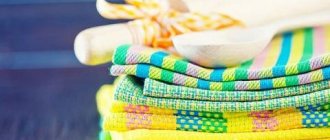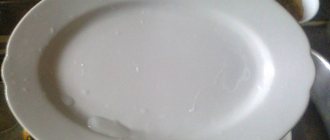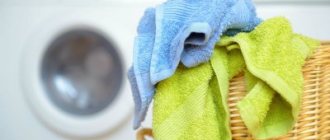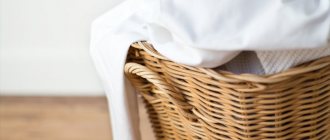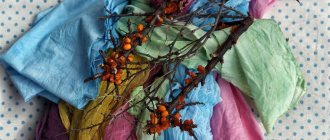Home / Care
Back
Published: 05/23/2021
Reading time: 3 min
0
16
Washing kitchen towels is a difficult task, but it can be solved. There are quite a lot of methods and means that will help restore their freshness and purity.
- 1 Normal wash with or without soaking
- 2 Methods with vegetable oil
- 3 Use of a microwave oven
- 4 Boiling
- 5 Home remedies
- 6 Purchased chemicals
- 7 Tea and coffee stains
- 8 Eliminate odor
- 9 Conclusion
Washing, soaking, bleaching and boiling kitchen towels with vegetable oil: recipe
The right approach to washing kitchen towels will help you achieve their ideal cleanliness, freshness and a beautiful, neat appearance. You can remove any stain, even one that does not “take” the powder; it is only important to choose the right method and follow the rules.
Few people know that you can wash kitchen towels in such an unusual and exotic way as “using oil.” For this, you will need any vegetable oil; sunflower oil is most often used (it is not expensive and can always be found in the store).
This type of washing consists of three stages:
- Soaking with oil
- Regular wash
- Intensive rinse
For soaking you will need to have a bucket or basin. Pour oil into it (literally 2-3 tbsp) and add exactly a glass of powder, which is mandatory for automatic machines (you choose yourself, focusing on the type of towel material). Fill everything with hot water and dip all the towels in it. This soaking is quite long and should last all night (8-10 hours).
INTERESTING: Oil in this case, the oil in the basin will attract and activate the active particles of the washing powder.
This method is very effective for those towels that are stained with grease. After soaking, a full machine wash cycle and rinsing twice (first with hot and then with regular cold water), you can get an incredible effect - clean, like new towels “from the store.”
How to restore perfect cleanliness to greasy kitchen towels?
Methods for removing stains
Before the advent of modern detergents and cleaning products, housewives were actively looking for improvised methods and means to wash dirty kitchen towels. They are still used today.
Laundry soap, shampoo, dishwashing detergents
Before washing, moderately soiled areas on kitchen towels are rubbed with laundry soap and washed. Stains that are firmly ingrained into the fabric are intensively treated with a soap bar, after which the products are placed in a plastic bag for a day. Then rinse the fabric in warm water.
A good solution for removing different types of stains is a mixture of simple ingredients. Soap shavings soaked in boiling water are combined with 6 drops of ammonia and 6 crushed tablets of hydrogen peroxide. Place kitchen textiles into the prepared solution and leave until cool. All that remains is to wash the towels.
Apply hair shampoo to fruit stains for half an hour, then wash the product.
Experienced housewives know how to remove oil stains that appear on kitchen utensils. For this purpose, use a dishwashing concentrate. Apply the product to problem areas, leave for a day, rinse and wash with bleach powder. The method is applicable for white and colored fabrics.
Soda and salt
You can wash kitchen towels in the machine at a temperature of 90 °C in the “cotton” mode, adding a glass of baking soda to the powder compartment.
Mixing 3 tbsp. l. soda ash with the same volume of detergent, pour hot water and leave the products in the solution until the morning.
Table salt will help solve the problem of how to remove stains that are deeply ingrained into the fabric. For 5 liters of water you will need 5 tbsp. l. salt. Keep the items in the solution for an hour and then wash them in the machine. Traces of coffee and tomato juice will disappear.
Citric acid, vinegar and hydrogen peroxide
Housewives use table vinegar or diluted essence to remove stains. Towels are treated in an acidic solution for 10 minutes and rinsed thoroughly. The method is effective for removing mold from fabric and eliminating kitchen odors.
We recommend reading: Methods for controlling mice in a private house and apartment
Old stains are removed by treating with wine vinegar, followed by rinsing.
Citric acid is used as an alternative. Towels washed with laundry soap are wrung out and citric acid powder is poured onto problem areas. After waiting 5-10 minutes, rinse the kitchen utensils. The method is good for combating stains from beets and tomatoes.
Hydrogen peroxide is applied to old stains for half an hour. Then wash the fabric as usual.
Silicate glue and mustard
Considering that silicate glue is included in cleaners, it is also used to remove stains. But only for white fabrics. Pour boiling water over a mixture of soap shavings from one bar and 1 tbsp. l. glue. Dip dirty towels into the solution, boil for 30 minutes, then rinse.
Add water to the mustard powder until a paste is obtained. The mixture is applied to heavily soiled areas, after which the product is washed by hand or machine.
Mustard is used to remove oil stains and whiten fabrics. The powder is poured into water and kitchen utensils are soaked in the liquid. Then they wash it.
Washing, soaking, bleaching and boiling kitchen towels with soda ash: recipe
Soda ash is not the usual baking soda, but a special alkali that can react with several types of contaminants and effectively combat them. This soda is often used for cleaning any surfaces in the kitchen, sinks, tiles, dishes, and even washing kitchen towels.
IMPORTANT: Soda ash can be added to washing powder in an automatic machine; it will not harm it. The product is very effective on white fabrics and towels.
Recipe with baking soda and soap:
- Soda (soda ash) – 3 tbsp.
- Liquid laundry soap – 3 tbsp.
How to wash:
- Pre-soak for 1.5-2 hours
- Place towels in the machine
- Pour the powder and soda into the compartment
- Turn on the washing temperature at 50-90 degrees (white towels) and 30-40 degrees (colored towels).
IMPORTANT: This type of washing can also be done by hand after soaking. Instead of soap, you can also use any washing gel or powder. Rinsing can be done several times (to achieve a better effect).
Soda ash is a “true” and effective method
Soda
Baking soda is an effective stain remover and whitening agent. It acts gently on linen without disturbing the structure of the fabric.
Dilute baking soda with water (1 tablespoon per 1 liter of water) and soak the laundry for 1 hour. Then wash as usual. If you want to further whiten light-colored kitchen towels, add ammonia to the solution (0.5 tbsp per 1 liter of water).
If there are old marks on the towels, you can additionally treat them with soda paste before soaking. Mix baking soda with water to form a paste, apply to stains, and leave for 30 minutes. Then start soaking.
Homemade fabric softener can be made from baking soda and a couple of drops of your favorite essential oil. Dilute the ingredients in water and rinse with kitchen towels
Washing, soaking, bleaching and boiling kitchen towels with laundry soap: recipe
Boiling is a very “old” but effective way to dissolve and remove greasy stains on white and colored kitchen towels. During boiling, greasy stains dissolve under the influence of high temperatures, and soap destroys fat, corroding it. You can use both a regular bar of laundry soap and modern liquid laundry soap.
INTERESTING: This type of soap is considered universal, as it is ideal for any household purposes, cleaning and washing.
"Manual" method:
- Dirty towels should be thoroughly wetted (with any water)
- Take a bar of soap and scrub all dirty areas (or the entire towel) well.
- Such a “soaped” towel should be placed in polyethylene or any bag, tightly twisted and tied.
- The towel should be kept in this state for several hours (or all night).
- In the morning, they should be washed by hand or by machine at high or medium temperatures (for colored ones).
IMPORTANT: Any boiling should be done only for light and white towels, bright and dark ones will lose their color.
Boiling method:
- For this method, you need to choose the right container, for example, an enamel basin or a bucket.
- Place a bar of soap in it (or pour a bottle), completely dissolve and bring the liquid to a boil.
- To ensure that the soap dissolves quickly, it is better to rub it with a grater.
- The liquid in the dish should be cloudy and even a little thick.
- All contaminated towels should be dipped into the liquid and, turning the heat to moderate (the water should not boil), cook them for about half an hour.
- Do not rush to remove the towels; let them sit in the liquid until they cool down.
- After this, you can do a regular or machine wash.
Laundry soap for towels
How to boil laundry at home: equipment and equipment
Before starting the procedure, study the technique of the procedure and its rules. This will protect things from deformation and save your time.
- Preparation of the solution. Dilute the treatment agent completely. If it is laundry soap, grate it. This way it will dissolve much faster.
- Sorting laundry. Separate white items from colored items, sort cotton items and linen items.
- Soak. Soak heavily soiled items in a boiling solution in advance.
- Boiling process. Place the laundry in the solution until it boils. If you throw soiled clothes into boiling water, the dirt may “cook” and you will no longer be able to wash it off. The water should completely cover the items being boiled. Do not put too many clothes: the less, the better the effect of boiling.
- Mixing. Don't forget to stir things periodically so they boil evenly. After the solution boils, reduce the heat so that the foam does not run off onto the stove.
- Disinfection. To restore whiteness and remove germs, boil already cleaned fabrics.
- Rinsing. After boiling, rinse things in cool water and wring out.
- Drying. Dry clean clothes outdoors in the sun to make them fresher and more fragrant.
Prepare the necessary equipment in advance. The procedure requires only three components.
- Pot. Take containers for boiling that are not chipped, made of enamel or stainless steel. Make sure that there is no rust on the boil-off, otherwise red marks may remain on the material that will no longer be removed.
- Forceps. Necessary for mixing laundry. Take wooden, long ones. A ladle, rolling pin or boiled stick will also work.
- Solution. There is a large selection of components. Laundry soap, bleach or Vanish stain remover are often used. The effect will be better if you combine several products at once.
Before boiling, be sure to check the information on the clothing label to see if it can be subjected to high-temperature treatment. Natural fabrics tolerate boiling well, while synthetic products become deformed during boiling.
Washing, soaking, bleaching and boiling kitchen towels with vinegar: recipe
INTERESTING: Surprisingly, ordinary table or fruit vinegar can be an excellent means for washing fabrics, which preserves their color, returns whiteness and removes stains.
Vinegar can even be added to the washing machine, because it will not harm either things or the device itself. It is often added only because it prevents streaks and traces of powder from appearing on fabrics and makes the material incredibly soft. And for an automatic machine, vinegar is useful because it can kill bacteria that can accumulate and multiply inside it.
How to boil and soak:
- Vinegar should only be used on kitchen towels and rags that are made from natural materials (linen or cotton).
- You don’t need a lot of vinegar and only 1-2 tbsp. per liter of water will be quite enough for both washing and soaking.
- Soaking must be done for at least an hour. Use any vinegar you find (except dark ones: currant, balsamic).
- After soaking, you can proceed to boiling (for very dirty ones) and regular washing (for colored towels).
IMPORTANT: To ensure that the towel has a pleasant aroma and does not smell of vinegar, use fruit vinegar, not table vinegar.
How to do laundry with vinegar correctly?
Terms of use
The rules for using kitchen towels are simple and allow you to avoid the painful washing of stains. To reduce difficult-to-remove contaminants, it is recommended:
- have separate copies for hands and utensils;
- do not wipe work surfaces with a towel;
- do not use as potholders;
- wash your hands thoroughly and only then dry them;
- change towels more often;
- Clean towels must be ironed: this way the fabric gets less dirty.
Kitchen surfaces should be wiped with an absorbent wipe. To blot up dirt on the table, it’s better to take a paper towel.
Terry products are not suitable for use in the kitchen. Fat is firmly ingrained into numerous fibers, and persistent colored stains are extremely difficult to remove. In addition, fluffy products take a long time to dry, which leads to the growth of bacteria and mold in the fabric fibers. Linen products or cotton waffle fabrics are suitable for use in the kitchen.
Washing, soaking, bleaching and boiling kitchen towels using mustard: recipe
Surprisingly, regular mustard powder is an excellent solution for washing dirty kitchen towels. Mustard is effective in that it can not only “remove” stains, but also whiten and disinfect fabrics. You can do several types of washing with it:
- Soak
- Boiling
- Hand wash
INTERESTING: You can buy mustard powder at any grocery store or supermarket.
What you will need:
- Mustard powder – 50 g bag.
- Boiling water – 0.5 buckets (in which you will boil)
What to do:
- Bring the water to 3-40 degrees
- Dissolve mustard in a bucket
- Dip towels
- Keep them in a bucket until cool (this will be a pre-soak).
- Towels should be soaked for as long as the contamination requires (lightly soiled ones will take less than an hour, heavily soiled ones will take about 3-4 hours).
- It will be useful to boil those towels that have greasy stains. To do this, place the dishes on the fire and “cook” for about half an hour.
- Then do a standard machine wash or hand wash.
IMPORTANT: For a more gentle wash, you can use the mustard powder rubbing method. To do this, dry mustard is diluted with water into a paste and all dirty places on wet towels are coated with it. After that, the towel needs to be twisted and folded, hidden in a bag, and kept for a day.
Effective washing with mustard
Boiling for pollution control
Kitchen towels, the washing of which did not give the desired result, are boiled. Substances that can corrode or soften stubborn dirt are added to boiling water.
- A common method is boiling in a soap solution. To do this, add washing powder and stain remover to the water. It is better to simmer over low heat for 3-4 hours, stirring occasionally.
- Here's how to wash towels using boiling water and vegetable oil. Mix 30 g of oil, 10 g of soda, 200 g of powder and 100 g of bleach. Boiling lasts one and a half to two hours, after which the product is washed. Baking soda or soda ash is used.
- It will help to wash away stubborn dirt by boiling towels in a soap solution with the addition of ammonia (13-15 drops per 5 liters).
- You can replace ammonia with three tablets of hydrogen peroxide dissolved in water.
- Soapy water with soda (2-3 dessert spoons of soda per 5 liters of water) can cope with dirt on towels if you boil them for 2 hours.
We recommend reading: Work hard and things will become boiling white
Washing, soaking, bleaching and boiling kitchen towels with potassium permanganate: recipe
Good old potassium permanganate will help whiten dirty and faded towels. You will need powdered potassium permanganate, which you need to add to the water to make a solution (it should be pale pink).
How to whiten:
- Wash dirty towels in the machine
- Already clean, put them in an enamel bucket
- Dilute potassium permanganate in warm water; it should be slightly pink.
- Dip washed and rinsed towels into warm liquid
- Cover the bucket with plastic
- Keep the towels in the water until it cools down
- After this, do another machine rinse (or manual).
Washing with potassium permanganate
Boiling
Although outdated, it is a very effective way to get rid of stains.
Dilute a standard amount of powder or soap shavings in an enamel bucket, add soda or salt to enhance the effect (1 tablespoon per 1 liter of water). You can add a little dishwashing detergent. Boil the towels for 30 minutes (or 1 hour if heavily soiled). After the procedure, rinse the laundry thoroughly.
Never use the boiling method on brightly colored kitchen towels.
Washing, soaking, bleaching and boiling kitchen towels in hydrogen peroxide: recipe
You can bleach towels and remove light and heavy stains from them using a “homemade” detergent such as hydrogen peroxide and soda.
How to do it:
- You only need 1-2 tsp. peroxide per 2 liters of hot water (no more than 70 degrees).
- Dissolve peroxide well in water and dip towels into the prepared solution.
- Keep them in the solution for about 10-15 minutes
- After this, rinse or run a wash cycle with towels in the machine.
Eliminate odor
Sometimes kitchen towels cannot get rid of the "smell" of dampness or grease even after an intensive wash cycle. Potassium permanganate will help to “defeat” the smell and restore the aroma of freshness.
Several manganese crystals are placed in the water to create a slight pinkish tint. The towel is treated with laundry soap and soaked in the prepared solution for 8 hours. Then rinse thoroughly.
Vinegar does a good job of removing specific aroma. Bacteria that cause an unpleasant odor die upon contact with an acidified environment. Dissolve a faceted glass of table vinegar in a bucket of water. Soak for an hour, wash according to the standard procedure.
When washing kitchen towels in an automatic machine, it is recommended to add a spoonful of soda along with the detergent. Additionally, 200 ml of table vinegar is poured into the air conditioner compartment.
Washing, soaking, bleaching and boiling kitchen towels in the microwave: recipe
INTERESTING: The microwave is a very unusual, but effective way to “remove” various types of dirt from kitchen towels. The only thing you need to know is that for particularly “heavy” stains, you will need to perform this procedure twice or even three times. The method of treating stains using a microwave is completely “new” and is effective in that it is able to influence stains molecularly, destroying the stain inside the fabric.
What do we have to do:
- Wet the towel generously (a dry towel should not be placed in the microwave because it may catch fire).
- A wet towel should be generously soaped with washing gel, soap, laundry soap, liquid dishwashing soap.
- Place the towel in a microwave-safe plastic bag.
- Roll the bag well and tightly
- Place the package on the bowl in the microwave
- The time to “cook” the towel in the oven is 1-1.5 minutes
- After this, take a “break” and turn on the oven again for 1 minute.
Cleaning towels in the microwave
Using a microwave oven
A classic microwave will help you effectively wash and bleach kitchen towels. The technique allows you to cope with most types of pollution.
The fabric must be wetted and then treated with laundry soap. If its type allows, then it is allowed to use a stain remover. Squeeze lightly and place in a thick polyethylene bag. Don't tie it! Place the “workpiece” in the chamber, set the maximum power. Run the unit for 3 minutes.
Fact! If one cycle is not enough, then the process can be repeated two to three times.
After this, the textiles are washed according to the standard procedure.
Author:
Anastasia Kukushkina
I hope you enjoy the article I have prepared for you! If you find errors in it, write to me about it! I will answer any questions you have, ask them!

